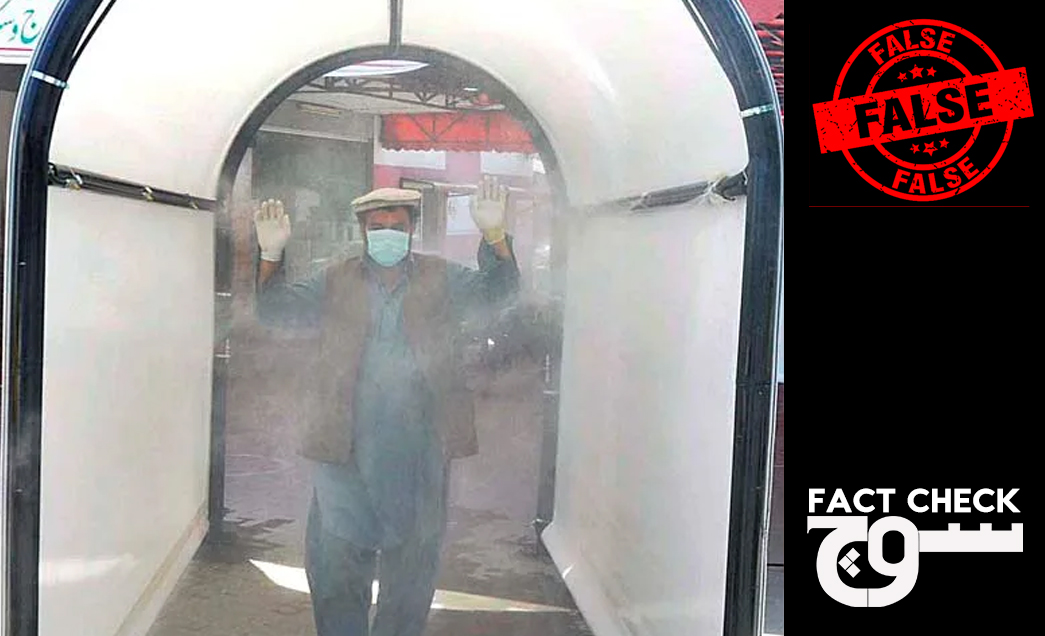
Claim: Walk-through disinfection gates kill the virus that causes Covid-19 and helps restrict its transmission.
Fact: Spraying water, chlorine (bleach) and alcohol over the body does not prevent the spread of Covid-19.
In the earliest stages of the pandemic, various methods of discouraging the spread of the virus had been put in place by local and provincial governments. Walk-through sanitization gates or disinfection tunnels are one of them.
As recently as 2 May 2020, the federal and provincial governments have been expanding the use of walk-through disinfection gates to address the Covid-19 crisis. These gates are locally constructed with their cost depending on their size. The gates are meant to be placed at the entrance of shops and workplaces so people walking in are sprayed with a mixture of water and chlorine to disinfect their bodies. On 9 April 2020, the Pakistan Medical Association (PMA) urged the government to make it mandatory for public and private sector companies to install such gates at their points of entry and exit.
Touqeeruddin, project manager at the research organisation Emintechs, told Dawn News in a 9 April 2020 article that “Usually, 250 millilitres of bleach is included in 10 litres of water but there are many formulas available on the internet to use the amount of bleach for different surfaces and for different germs.”
Soch contacted manufacturers of disinfection gates to confirm that different versions of the same diluted bleach and water formula was being used for spray disinfecting. Various sanitization gate manufacturers and importers have listed combinations of chlorine and water as the disinfectant liquid used in these gates online.
The World Health Organization (WHO) on 12 February 2020 issued a press release on their social media regarding disinfection gates utilizing sprays of chlorine and water, saying that the mixture will not kill viruses that have already entered an individual’s body. Furthermore, the press release clearly stated that “spraying such substances can be harmful to clothes or the body’s mucous membranes (ie., eyes, mouth).” According to WHO, these chemicals are only useful in disinfecting hard surfaces.
Although the solution cannot harm viruses that have already entered the body, this might raise questions about the benefits of using chlorine to disinfect clothes and skin, which are considered soft surfaces. WHO recommends avoiding the use of spraying chlorine on such soft surfaces for two reasons. First, both WHO and CDC report that chlorine solutions and other disinfectants are inactivated by the presence of organic matter and other kinds of dirt. Cleaning with detergent and water before applying disinfectant helps prevent inactivation of the disinfectant by organic matter. No such procedures are undertaken with regards to disinfection gates.
Moreover, given that soft surfaces usually comprise weaker materials such as organic fibers, synthetic fibers, or human skin, bleach mixtures may permanently damage soft surfaces such as fabrics and mucous membranes (eyes, mouth etc.) without achieving the desired disinfection because creases and irregularities in the soft surface will make it impossible for bleach to properly dwell on the surface to achieve the level of contact required for disinfection (recommended by the CDC as 5 minutes for hard surfaces). On the other hand, if left to sit indefinitely, bleach can damage even very hardy materials like steel.
Soch also contacted experts at the Aga Khan University Hospital to ask them whether sanitization gates offer any benefit to the public in preventing the spread of Covid-19. Dr Faisal Mahmood, Associate Professor of Infectious Diseases, informed us that it is likely that they have no benefit in this regard, not even minor or superficial benefits, duplicating the WHO press release shared above.
Summary: Sanitizing gates placed outside businesses, government and private offices, malls, shops, schools, and prisons, do nothing to prevent person-to-person transmission of Covid-19.
